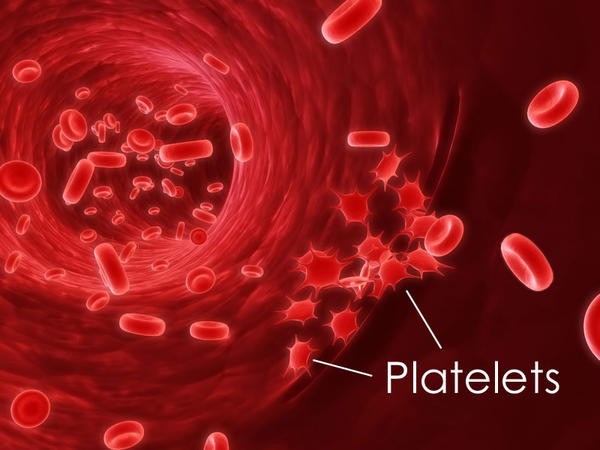 Platelets are small, colorless blood cells-like structures, which are essential for blood clotting and help plug damaged blood vessels. A laboratory test can help you find your platelet count. Normal range is between 150,000 and 450,000 per micro liter, but it may vary slightly among different laboratories. If you have more platelets in your blood, it means your platelet count is higher, which may be caused by many conditions and lead to several complications. Generally, high platelet count usually makes your blood clot unnecessarily throughout the body, which may prove lethal in some cases.
Platelets are small, colorless blood cells-like structures, which are essential for blood clotting and help plug damaged blood vessels. A laboratory test can help you find your platelet count. Normal range is between 150,000 and 450,000 per micro liter, but it may vary slightly among different laboratories. If you have more platelets in your blood, it means your platelet count is higher, which may be caused by many conditions and lead to several complications. Generally, high platelet count usually makes your blood clot unnecessarily throughout the body, which may prove lethal in some cases.
Causes of High Platelet Count
When your lab report confirms, "platelet count high", it is important to find the underlying cause. You may have elevated platelets because of many different reasons. The experts usually divide it into two different categories – primary thrombocythemia and secondary thrombocytosis.
1. Primary Thrombocythemia
In this disease, your bone marrow starts making too many platelets without any particular reason. It usually happens due to the overgrowth of a type of cell used in the making of blood cells. This affects your platelets the most, but the condition sometimes involves white and red blood cells as well. The platelets fail to work properly and the condition gets worse with time.
The disease is actually a part of a group of conditions referred to as myeloproliferative disorders. Others include polychtemia vera, chronic myelogenous leukemia, primary myelofibrosis, etc. It usually affects people in the middle age, but it may also affect younger people, particularly women under 40 years old.
2. Secondary Thrombocytosis (Reactive Thrombocytosis)
You may notice your platelet count going up due to some other health conditions. A wide range of diseases can lead to high platelet count, including:
- Anemia
- Cancer and chemotherapy
- Blood loss
- Severe infection
- Inflammatory disorders, like Kawasaki disease which is the inflammation of the blood vessels
- Myelodysplasia, a group of conditions in which your blood cells aren't normal
- Polycythemia vera, a rare disorder of the bone marrow that triggers production of blood cells
- Myelofibrosis, a disorder that products scar tissues in your bone marrow
- Reaction to steroids or other medications
- Surgical removal of the spleen
Treatments for High Platelet Count
In order to apply a right treatment plan for high platelet count, it is important to identify the underlying cause first. Your healthcare provider may use different approaches to treat primary thrombocythemia and secondary thrombocytosis.
1. Treating Primary Thrombocythemia
Medications
Some people may not have any symptoms at all, so they don't need treatment as well. You may have to take aspirin regularly to avoid blood clotting. It is important to consult your doctor before taking aspirin because its overuse may lead to bleeding.
Aspirin is also a good choice for pregnant women with primary thrombocythemia because it is not that dangerous for the fetus. In some situations, it is important to use medicines that would help lower high platelet count. Taking specific medications becomes essential when you have a history of bleeding or clotting, you are older than 60, or you have risk factors for cardiovascular disease, such as hypertension, high blood cholesterol and diabetes. Your doctor will prescribe these medicines when your platelet count is over 1 million. You usually need to take these medications for as long as you live.
Here are some of the most common medicines used to lower high platelet count:
- Hydroxyurea: Usually used to treat cancers, this medicine can help lower your platelet count. The combination of hydroxyurea and aspirin is the standard treatment for primary thrombocythemia these days. It is important to take this medicine under the supervision of a cancer specialist.
- Anagrelide: Some experts may use this medicine to lower your platelet count, but the research has shown that it is not as effective as hydroxyurea is. The medicine also has some side effects, such as arrhythmias, palpitations, fluid retention, headaches and heart failure.
- Interferon Alfa: It is another available treatment option to lower platelet count, but about 20% of patients fail to handle its side effects. Some of the most common side effects include decreased appetite, seizures, nausea, diarrhea, sleepiness, irritability and a flu-like feeling. The medicine is usually safer for a fetus, so it is a preferred choice for pregnant women.
Plateletpheresis
The procedure helps lower your platelet count at a rapid pace, so it is a suitable choice in emergencies only. Your doctor may suggest plateletpheresis if you're having stroke due to your high platelet count. The procedure involves taking blood out through an intravenous needle and then goes through a machine that separates blood and platelets. The blood is then put back in your body through another IV line. One or two procedures are usually enough to bring your platelet count to normal.
2. Treating Secondary Thrombocytosis
Since there's an underlying condition that increases your platelet count in the condition of secondary thrombocytosis, the treatment option involves addressing that condition only. You don't usually need any platelet-lowering procedures or medicines if you have secondary thrombocytosis. Moreover, it is unlikely for secondary thrombocytosis to cause serious problems related to bleeding and clotting.